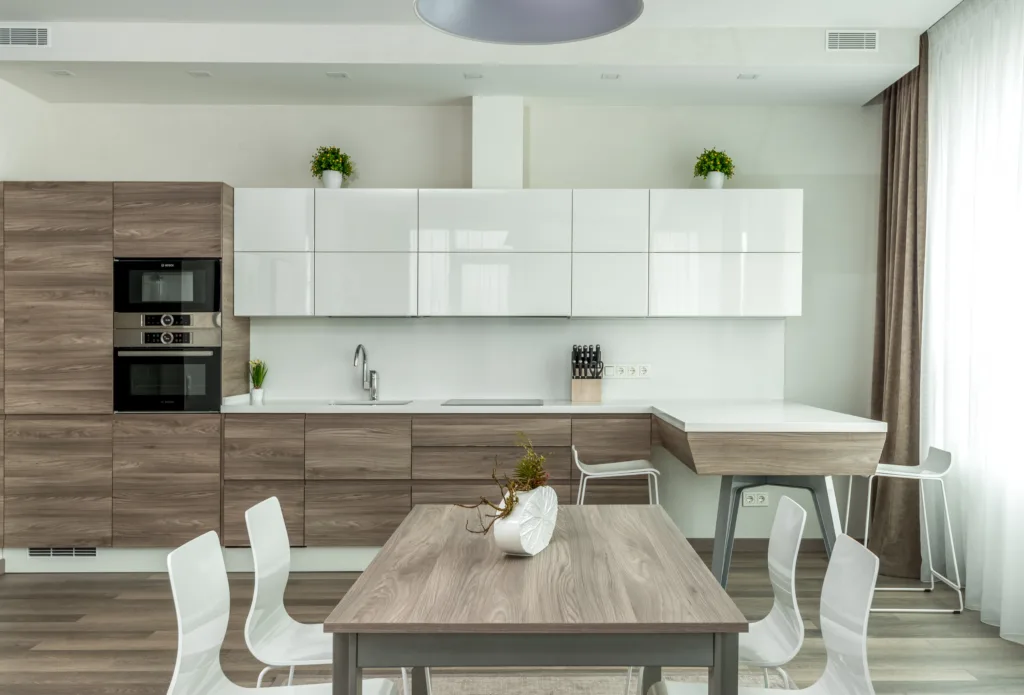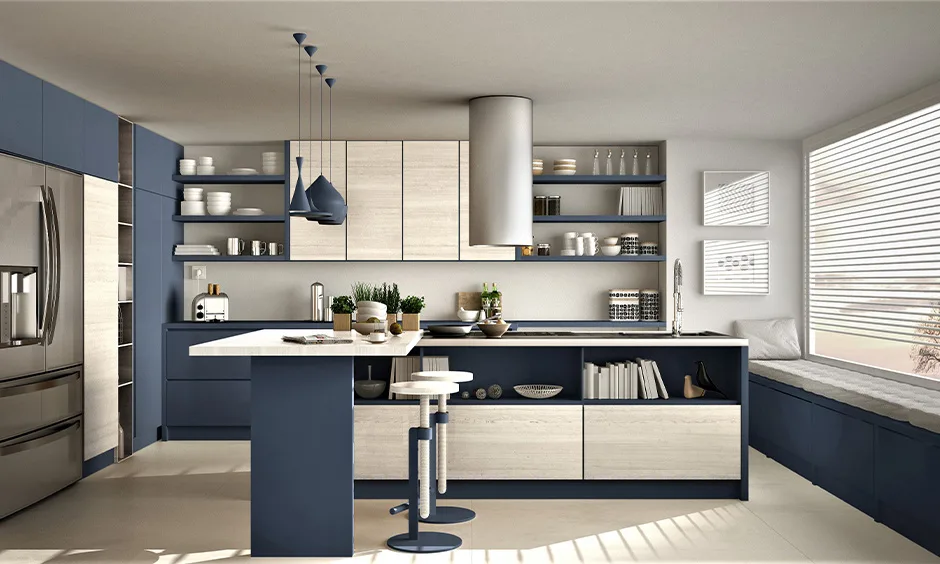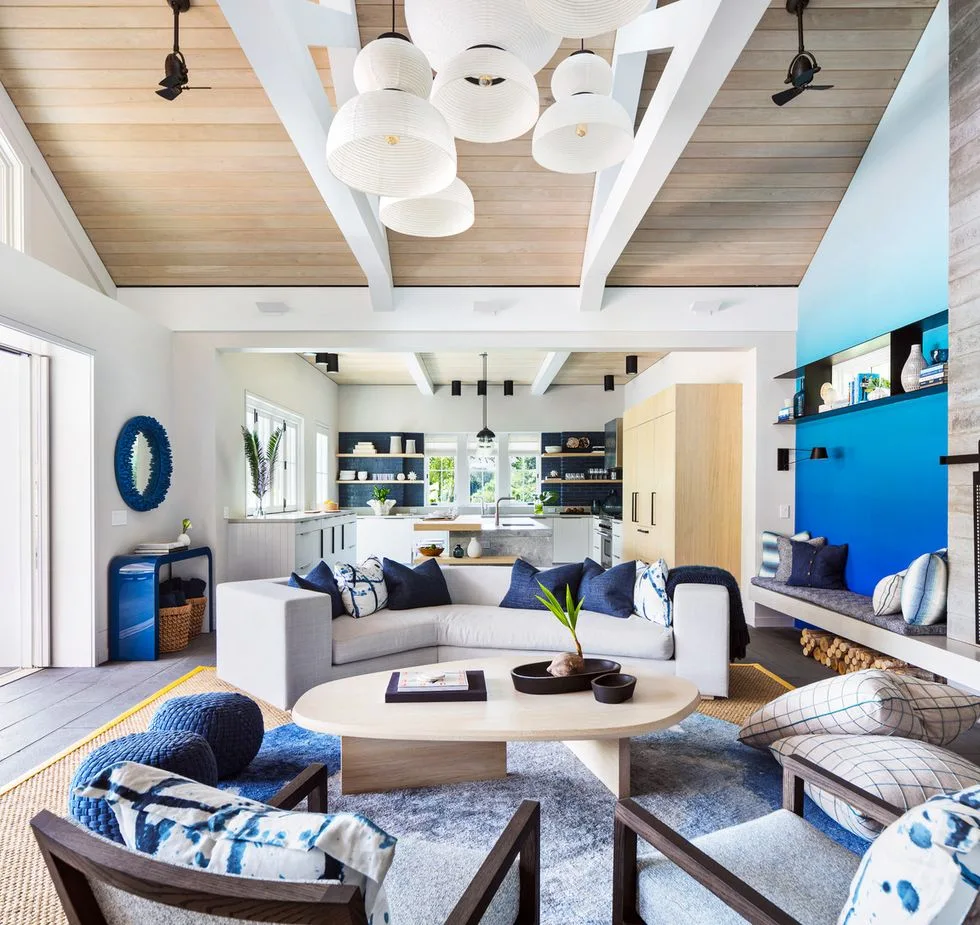
An open-concept kitchen is a popular design trend that involves removing walls and barriers to create a seamless flow between the kitchen and the rest of the living area. It provides a spacious and airy feel, allowing for easy interaction and communication between family members and guests. With an open-concept kitchen, you can cook, entertain, and relax all in one space.
What does an open kitchen mean?
An open kitchen is a layout where the cooking space is not separated from the dining or living area, creating a seamless and integrated space. This concept has gained popularity in recent years as it promotes a sense of openness and connectedness in the home. In an open kitchen, the boundaries between the kitchen and the rest of the living space are blurred, allowing for easy interaction between the cook and other members of the household or guests.
This design is often associated with modern and contemporary home styles and is favored for its social and functional aspects. However, it’s important to note that an open kitchen doesn’t offer much in terms of privacy.
Why are open kitchens popular?

Open kitchens have gained popularity for several reasons:
- More Usable Space: By eliminating walls that separate the kitchen from other areas, open kitchens create a spacious and airy atmosphere.
- Increased Interaction: The open layout allows for easy movement and communication between different zones, making the space feel larger and more inviting.
- Entertaining and Socializing: Open kitchens are ideal for hosting gatherings as they allow the cook to interact with guests or family members.
- Visual Appeal: Watching the cooking process can be entertaining for diners, and an open kitchen allows chefs to showcase their skills.
- Modern Lifestyle: Our lifestyles have become less formal, and open-concept floor plans were popularized as a more casual way of living.
- Trust and Transparency: An open kitchen allows diners to see how their food is prepared, which can build trust.
Remember, while open kitchens have many benefits, they may not be the right choice for everyone. It’s important to consider your specific needs and lifestyle when designing your kitchen space.
Tips on How to Design a Functional and Stylish Open Kitchen

Open-kitchen plans have become increasingly popular in modern home design. They offer a spacious feel and allow for easy interaction between the kitchen and other living spaces. However, designing an open kitchen that is both functional and stylish can be a challenge. Here are some tips and tricks to help you create the perfect open-kitchen plan.
1. Define Your Spaces
Even though an open-kitchen plan is all about creating a seamless flow between spaces, it’s still important to define each area. This can be achieved through the strategic placement of furniture, different flooring materials, or even a change in wall color.
2. Consider the Work Triangle
The work triangle – the distance between your sink, stove, and refrigerator – should be efficient to make cooking easier. In an open kitchen, it’s even more important to keep this triangle compact to avoid unnecessary steps.
3. Use a Kitchen Island
A kitchen island can act as a buffer between the kitchen and living areas. It provides extra storage and counter space, and can also double as a dining table or breakfast bar.
4. Opt for Consistent Design Elements
To create a cohesive look, carry the same design elements throughout the space. This could be in the form of matching cabinetry, consistent flooring, or a unified color scheme.
5. Think About Storage
In an open kitchen, clutter can easily spill over into the living areas. Incorporate plenty of storage solutions – like cabinets, shelves, and baskets – to keep everything tidy.
6. Pay Attention to Lighting
Lighting plays a crucial role in open-kitchen plans. Use a mix of ambient, task, and accent lighting to create a warm and inviting atmosphere.
7. Don’t Forget About Ventilation
Cooking smells can easily permeate an open kitchen space. Invest in a good-quality range hood to keep your living areas fresh.Designing a functional and stylish open kitchen plan involves careful planning and thoughtful design. But with these tips and tricks, you can create a space that is both practical and aesthetically pleasing.
Open-concept Kitchen Design Considerations
When designing an open-concept kitchen, consider the layout by assessing the size, shape, and window-door placements for efficient appliance and counter positioning. Ensure a logical traffic flow with enough space for movement and minimal obstruction to cooking areas, possibly using kitchen islands or designated walkways. Finally, match the kitchen’s aesthetic with your home’s style, choosing materials and finishes that align with your preferred theme, whether modern or farmhouse.
Choosing the right layout for your open-concept kitchen

Designing an open-concept kitchen involves careful planning and consideration to ensure the space is both functional and aesthetically pleasing. Here are key considerations to keep in mind:
1. Space Layout and Flow
- Integration with Living Areas: The kitchen should seamlessly connect with adjacent living spaces, such as the dining and living rooms, promoting interaction and movement.
- Zoning: Even in an open layout, it’s important to define different zones for cooking, dining, and living. This can be achieved through strategic placement of furniture, kitchen islands, or varying floor materials.
2. Functionality
- Work Triangle: Consider the placement of the sink, refrigerator, and stove. They should be arranged for efficient movement between tasks.
- Storage Solutions: Open kitchens often have less wall space for cabinets, so incorporating clever storage solutions like pull-out cabinets, corner units, and multi-tiered drawers is crucial.
3. Lighting
- Layered Lighting: Combine ambient, task, and accent lighting to create a well-lit but cozy environment. Consider pendant lights over the island, under-cabinet lights for tasks, and soft overhead lighting for ambiance.
- Natural Light: Maximize the flow of natural light with large windows or skylights. This can make the space appear larger and more welcoming.
4. Ventilation
- Effective Range Hood: A high-quality range hood is essential to vent cooking smells and smoke, especially important in open layouts where kitchen odors can easily spread to other living areas.
- Air Circulation: Ensure there is good air circulation throughout the open space to maintain comfort and air quality.
5. Materials and Finishes
- Cohesive Design: Choose materials and finishes that complement the overall design of your home. The kitchen finishes should work harmoniously with the living and dining areas for a cohesive look.
- Durability: Opt for durable and easy-to-clean materials, especially for countertops and flooring, as they will see heavy use and should maintain their appearance over time.
6. Sound Management
- Acoustic Considerations: Open-concept spaces can be noisy. Use soft furnishings, rugs, and acoustic panels to absorb sound and reduce echo.
7. Personal Touches
- Decorative Elements: Add personal touches through decorative items, artwork, or unique kitchen gadgets that reflect your style and personality.
- Flexible Furniture: Choose furniture that can serve multiple purposes, like an island that can be used for food prep as well as dining, or a movable bar cart.
8. Budget
- Cost Considerations: Be mindful of your budget as open-concept kitchens can be expensive due to the larger footprint, higher quality finishes, and the need for structural changes.
9. Building Codes and Regulations
- Compliance: Ensure your design complies with local building codes and regulations, especially if structural changes are involved.
Selecting the perfect color scheme for your open-concept kitchen
Choosing the perfect color scheme for your open-concept kitchen can significantly enhance the overall aesthetic and mood of your space. Here are some tips to guide you in making the right choice:
- Understand Color Palettes: Use a color wheel to understand which colors complement each other. You can choose complementary colors (those opposite each other on the wheel) or analogous colors (three sections of the wheel that sit together).
- Consider Your Space: The size and shape of your kitchen can influence your color scheme. Light colors can make a small kitchen feel larger, while dark colors can add depth and warmth to a large kitchen.
- Think About Your Home’s Style: The architectural style of your home can guide your color choice. For instance, a modern kitchen might look best with bold, dramatic colors, while a country kitchen might suit soft, light hues.
- Don’t Go Monochromatic: Try to use different but complementary colors in your open kitchen. This can create a more dynamic and visually interesting space.
- Use Nature as Inspiration: Look to natural landscapes for color inspiration. Nature’s palettes are inherently harmonious and can inspire unique and beautiful color schemes.
- Test Your Colors: Before making a final decision, test your potential colors in your kitchen space. Observe them at different times of day and under different lighting conditions to ensure you’re happy with your choice.
Remember, the best color scheme for your open-concept kitchen is one that reflects your style and complements the rest of your home.
Conclusion
Designing your dream open-concept kitchen is an exciting endeavor that requires careful consideration and planning. By understanding the pros and cons of an open-concept kitchen, considering the layout and design elements, and incorporating functional and stylish features, you can create a space that is both inviting and practical.
Whether you prefer a modern, minimalist look or a cozy farmhouse vibe, there are endless possibilities for designing your dream open-concept kitchen. With the right combination of colors, lighting, storage solutions, and technology, you can transform your kitchen into the heart of your home. So, start envisioning your dream open-concept kitchen and turn it into a reality.
Contact Livermore ADU Builder & Room Addition
For professional assistance in designing and building your dream open-concept kitchen, contact Livermore ADU Builder & Room Addition. Our team of experts can help you bring your vision to life and create a functional and stylish space that fits your lifestyle and budget. Don’t wait any longer, take the first step towards your dream open-concept kitchen today!
Contact Livermore ADU Builder & Room Addition for a free consultation and turn your dream open-concept kitchen into a reality.

